Antioxidant Activity of Hydrogen Water Mask Pack Composed of Gel-Type Emulsion and Hydrogen Generation Powder
Abstract
:1. Introduction
2. Results
2.1. Characterization of Hydrogen Generation Powder Samples
2.2. Antioxidant and Antiradiacal Activities of the Hydrogen Generation Powder Samples
2.3. Clinical Test Hydrogen Mask Packs
3. Discussion
4. Materials and Methods
4.1. Preparation and Measurement of Hydrogen Generation of Powder Samples
4.2. Evaluation of Antioxidant and Antiradiacal Activities
4.2.1. Measurement of Reducing Properties
4.2.2. Measurement of Removal of ⋅OH Radical
4.2.3. Measurement of Ferric Reducing Antioxidant Power (FRAP)
4.3. Clinical Test Using Hydrogen Mask Pack
4.3.1. Subjects and Study Design
4.3.2. Measurement of Skin Biophysical Parameters
5. Conclusions
Author Contributions
Funding
Conflicts of Interest
References
- Ilaria, L.; Gennaro, R.; Francesco, C.; Giulia, B.; Luisa, A.; David, D.M.; Gaetano, G.; Gianluca, T.; Francesco, C.; Domenico, B.; et al. Oxidative stress, aging, and diseases. Clin. Interv. Aging 2018, 13, 757–772. [Google Scholar]
- Gianluca, T.; Francesco, C.; Gianluigi, G.; David, D.M.; Francesca, M.; Assunta, L.; Salvatore, R.; Gaetano, G.; Domenico, D.S.; Nicola, F.; et al. Waist circumference but not body mass index predicts long-term mortality in elderly subjects with chronic heart failure. J. Am. Geriatr. Soc. 2010, 58, 1433–1440. [Google Scholar]
- Birben, E.; Sahiner, U.M.; Sackesen, C.; Erzurum, S.; Kalayci, O. Oxidative stress and antioxidant defense. World Allergy Organ. J. 2012, 5, 9–19. [Google Scholar] [CrossRef] [PubMed] [Green Version]
- Pisoschi, A.M.; Pop, A. The role of antioxidants in the chemistry of oxidative stress: A review. Eur. J. Med. Chem. 2015, 97, 55–74. [Google Scholar] [CrossRef]
- Tyler, W.L.; Branislav, K.; Barbora, K.; Narcis, T.; Jan, S. A New Approach for the Prevention and Treatment of Cardiovascular Disorders. Molecular Hydrogen Significantly Reduces the Eects of Oxidative Stress. Molecules 2019, 24, 2076–2102. [Google Scholar]
- Hong, Y.; Chen, S.; Zhang, J.M. Hydrogen as a Selective Antioxidant: Review of Clinical and Experimental Studies. J. Int. Med. Res. 2010, 38, 1893–1903. [Google Scholar] [CrossRef] [Green Version]
- Peter, C.; Valerie, L. Medicalization, Markets and Consumers. J. Health Soc. Behav. 2004, 45, 158–176. [Google Scholar]
- Linda, S.; Matias, R.; Martin, N.F.; Gunnar, J. Percutaneous absorption of thirty-eight organic solvents in vitro using pig skin. PLoS ONE 2018, 13, 0205458. [Google Scholar]
- Mohammad, A.N.; Mohammad, A.A.; Payam, Z.; Abolfazl, S.M.; Tina, M.; Shiva, A.; Mahsa, M.S. Skin care and rejuvenation by cosmeceutical facial mask. J. Cosmet. Dermatol. 2018, 17, 1–10. [Google Scholar]
- Tsubone, H.; Hanafusa, M.; Endo, M.; Manabe, N.; Hiraga, A.; Ohmura, H.; Aida, H. Effect of treadmill exercise and hydrogen-rich water intake on serum oxidative and anti-oxidative metabolites in serum of thorough bred horses. J. Equine Sci. 2013, 24, 1–8. [Google Scholar] [CrossRef] [Green Version]
- De Siqueira, R.N.C.; De Albuquerque Brocchi, E.; De Oliveira, P.F.; Motta, M.S. Hydrogen reduction of zinc and iron oxides containing mixtures. Metall. Mater. Trans. B 2014, 45B, 66–75. [Google Scholar] [CrossRef]
- Rasleen, S.; Madhulika, B.; Sahil, G.; Jasvinder, S.; Anupurna, K. Iron (FeII) Chelation, Ferric Reducing Antioxidant Power, and Immune Modulating Potential of Arisaema jacquemontii (Himalayan Cobra Lily). BioMed Res. Int. 2014, 2014, 1–7. [Google Scholar]
- Harman, D. Aging—A theory based on free-radical and radiation-chemistry. J. Gerontol. 1956, 11, 298–300. [Google Scholar] [CrossRef] [PubMed] [Green Version]
- Ritz-Timme, S.; Laumeier, I.; Collins, M.J. Aspartic acid racemization: Evidence for marked longevity of elastin in human skin. Br. J. Dermatol. 2003, 149, 951–959. [Google Scholar] [CrossRef] [PubMed]
- Naylor, E.C.; Watson, R.E.; Sherratt, M.J. Molecular aspects of skin ageing. Maturitas 2011, 69, 249–256. [Google Scholar] [CrossRef] [PubMed]
- Jenkins, G. Molecular mechanisms of skin ageing. Mech. Ageing Dev. 2002, 123, 801–810. [Google Scholar] [CrossRef]
- Christopher, S.H.L.; Siew, L.L. Ferric reducing capacity versus ferric reducing antioxidant power for measuring total antioxidant capacity. Lab. Med. 2013, 44, 51–55. [Google Scholar]
- Ohta, S. Molecular hydrogen as a preventive and therapeutic medical gas: Initiation, development and potential of hydrogen medicine. Pharmacol. Ther. 2014, 144, 1–11. [Google Scholar] [CrossRef] [Green Version]
- Moris, D.; Spartalis, M.; Spartalis, E.; Karachaliou, G.-S.; Karaolanis, G.I.; Tsourouflis, G.; Tsilimigras, D.I.; Tzatzaki, E.; Theocharis, S. The role of reactive oxygen species in the pathophysiology of cardiovascular diseases and the clinical significance of myocardial redox. Ann. Transl. Med. 2017, 5, 326. [Google Scholar] [CrossRef] [Green Version]
- Ikuroh, O.; Masahiro, I.; Kumiko, T.; Megumi, W.; Kiyomi, N.; Kumi, Y.; Ken-Ichiro, K.; Yasuo, K.; Sadamitsu, A.; Shigeo, O. Hydrogen acts as a therapeutic antioxidant by selectively reducing cytotoxic oxygen radicals. Nat. Med. 2007, 13, 688–782. [Google Scholar]
- Dole, M.; Wilson, F.R.; Fife, W.P. Hyperbaric Hydrogen Therapy: A possible Treatment for Cancer. Science 1975, 190, 152–154. [Google Scholar] [CrossRef] [PubMed]
- Zoltán, N.; Lyuben, N.; Marekov, L.F.; Peter, M.S. A Novel Function for Transglutaminase 1: Attachment of Long-Chain ω -Hydroxyceramides to Involucrin by Ester Bond Formation. Proc. Natl. Acad. Sci. USA 1999, 96, 8402–8407. [Google Scholar]
- Alessandro, D.C.; Carmen, L.; Beniamino, P.; Tommaso, I. A dietary supplement improves facial photoaging and skin sebum, hydration and tonicity modulating serum fibronectin, neutrophil elastase 2, hyaluronic acid and carbonylated proteins. J. Photochem. Photobiol. B Biol. 2015, 144, 94–103. [Google Scholar]
- Halper, J.; Kjaer, M. Basic components of connective tissues and extracellular matrix: Elastin, fibrillin, fibulins, fibrinogen, fibronectin, laminin, tenascins and thrombospondins. Adv. Exp. Med. Biol. 2014, 802, 31–47. [Google Scholar]
- Takeuchi, H.; Gomi, T.; Shishido, M.; Watanabe, H.; Suenobu, N. Neutrophil elastase contributes to extracellular matrix damage induced by chronic lowdose UV irradiation in a hairless mouse photoaging model. J. Dermatol. Sci. 2010, 60, 151–158. [Google Scholar] [CrossRef]
- Jahns, A.C.; Eilers, H.; Ganceviciene, R.; Alexeyev, O.A. Propionibacterium species and follicular keratinocyte activation in acneic and normal skin. Br. J. Dermatol. 2015, 172, 981–987. [Google Scholar] [CrossRef]
- Wenk, J.; Brenneisen, P.; Meewes, C.; Wlaschek, M.; Peters, T.; Blaudschun, R.; Ma, W.; Kuhr, L.; Schneider, L.; Scharffetter-Kochanek, K. UV-induced oxidative stress and photoaging. Curr. Probl. Dermatol. 2001, 29, 83–94. [Google Scholar]
- Kitazawa, M.; Podda, M.; Thiele, J.; Traber, M.G.; Iwasaki, K.; Sakamoto, K.; Packer, L. Interactions between vitamin E homologues and ascorbate free radicals in murine skin homogenates irradiated with ultraviolet light. Photochem. Photobiol. 1997, 65, 355–365. [Google Scholar] [CrossRef]
- Shin, M.H.; Park, R.; Nojima, H.; Kim, H.C.; Kim, Y.K.; Chung, J.H. Atomic Hydrogen Surrounded by Water Molecules, H(H2O)m, Modulates Basal and UV-Induced Gene Expressions in Human Skin In Vivo. PLoS ONE 2013, 8, e61696. [Google Scholar] [CrossRef] [Green Version]
- Scharffetter-Kochanek, K.; Wlaschek, M.; Brenneisen, P.; Schauen, M.; Blaudschun, R.; Wenk, J. UV-induced reactive oxygen species in photocarcinogenesis and photoaging. Biol. Chem. 1997, 378, 1247–1257. [Google Scholar]
- Pageon, H.; Bakala, H.; Monnier, V.M.; Asselineau, D. Collagen glycation triggers the formation of aged skin in vitro. Eur. J. Dermatol. 2007, 17, 12–20. [Google Scholar] [PubMed]
- Yuan, J.; Wang, D.; Liu, Y.; Chen, X.; Zhang, H.; Shen, F.; Liu, X.; Fu, J. Hydrogen-rich water attenuates oxidative stress in rats with traumatic brain injury via Nrf2 pathway. J. Surg. Res. 2018, 228, 238–246. [Google Scholar] [CrossRef] [PubMed]
- Kura, B.; Bagchi, A.K.; Singal, P.K.; Barancik, M.; Le Baron, T.W.; Valachova, K.; Šoltés, L.; Slezák, J. Molecular hydrogen: Potential in mitigating oxidative-stress-induced radiation injury. Can. J. Physiol. Pharmacol. 2019, 97, 287–292. [Google Scholar] [CrossRef] [PubMed]
- Stewart, J.R.; Fajardo, L.F. Radiation-induced heart disease: An update. Prog. Cardiovasc. Dis. 1984, 27, 173–194. [Google Scholar] [CrossRef]
- Sanceau, J.; Boyd, D.D.; Seiki, M.; Bauvois, B. Interferons inhibit tumor necrosis factor-alpha-mediated matrix metalloproteinase-9 activation via interferon regulatory factor-1 binding competition with NF-kappa B. J. Biol. Chem. 2002, 277, 35766–35775. [Google Scholar] [CrossRef] [Green Version]
- Daly, C.H.; Odland, G.F. Age-related Changes in the Mechanical Properties of Human Skin. J. Investig. Dermatol. 1979, 73, 84–87. [Google Scholar] [CrossRef] [Green Version]
- Finkel, T. Signal transduction by reactive oxygen species. J. Cell Biol. 2011, 194, 7–15. [Google Scholar] [CrossRef] [Green Version]
- Endo, J.; Sano, M.; Katayama, T.; Hishiki, T.; Shinmura, K.; Morizane, S.; Matsuhashi, T.; Katsumata, Y.; Zhang, Y.; Ito, H.; et al. Metabolic remodeling induced by mitochondrial aldehyde stress stimulates tolerance to oxidative stress in the heart. Circ. Res. 2009, 105, 1118–1127. [Google Scholar] [CrossRef] [Green Version]
- Liu, Y.; Yang, L.; Tao, K.; Vizcaychipi, M.P.; Lloyd, D.M.; Sun, X.; Irwin, M.G.; Ma, D.; Yu, W. Protective effects of hydrogen enriched saline on liver ischemia reperfusion injury by reducing oxidative stress and HMGB1 release. BMC Gastroenterol. 2014, 14, 1–9. [Google Scholar] [CrossRef] [Green Version]
- Jazwa, A.; Cuadrado, A. Targeting Heme Oxygenase-1 for Neuroprotection and Neuroinflammation in Neurodegenerative Diseases. Curr. Drug Targets 2010, 11, 1517–1531. [Google Scholar] [CrossRef]
- Nguyen, T.; Nioi, P.; Pickett, C.B. The Nrf2-antioxidant response element signaling pathway and its activation by oxidative stress. J. Biol. Chem. 2009, 284, 13291–13295. [Google Scholar] [CrossRef] [PubMed] [Green Version]
- Oyaizu, M. Studies on products of browning reaction prepared from glucosamine. Jpn. J. Nutr. 1986, 44, 307–315. [Google Scholar] [CrossRef] [Green Version]
- Chung, S.K.; Osawa, T.; Kawakishi, S. Hydroxyl Radical-scavenging Effects of Spices and Scavengers from Brown Mustard (Brassica nigra). Biosci. Biotechnol. Biochem. 1997, 61, 118–123. [Google Scholar] [CrossRef] [Green Version]
- Benzie, I.F.F.; Strain, J.J. The ferric reducing ability of plasma (FRAP) as a measure of “antioxidant power”: The FRAP assay. Anal. Biochem. 1996, 239, 70–76. [Google Scholar] [CrossRef] [Green Version]
- Kojima, H. Considerations Regarding the Importance of In Vivo Data for the Development of an Alternative to Conventional Skin Irritation Testing. Altern. Anim. Test. Exp. 2005, 11, 31–38. [Google Scholar]
- Piet, E.; Erp, J.; Peppelman, M.; Falcone, D. Noninvasive analysis and minimally invasive in vivo experimental challenges of the skin barrier. Exp. Dermatol. 2018, 27, 867–875. [Google Scholar]
- Marrakchi, S.; Maibach, H.I. Biophysical parameters of skin: Map of human face, regional, and age-related differences. Contact Dermat. 2007, 57, 28–34. [Google Scholar] [CrossRef]
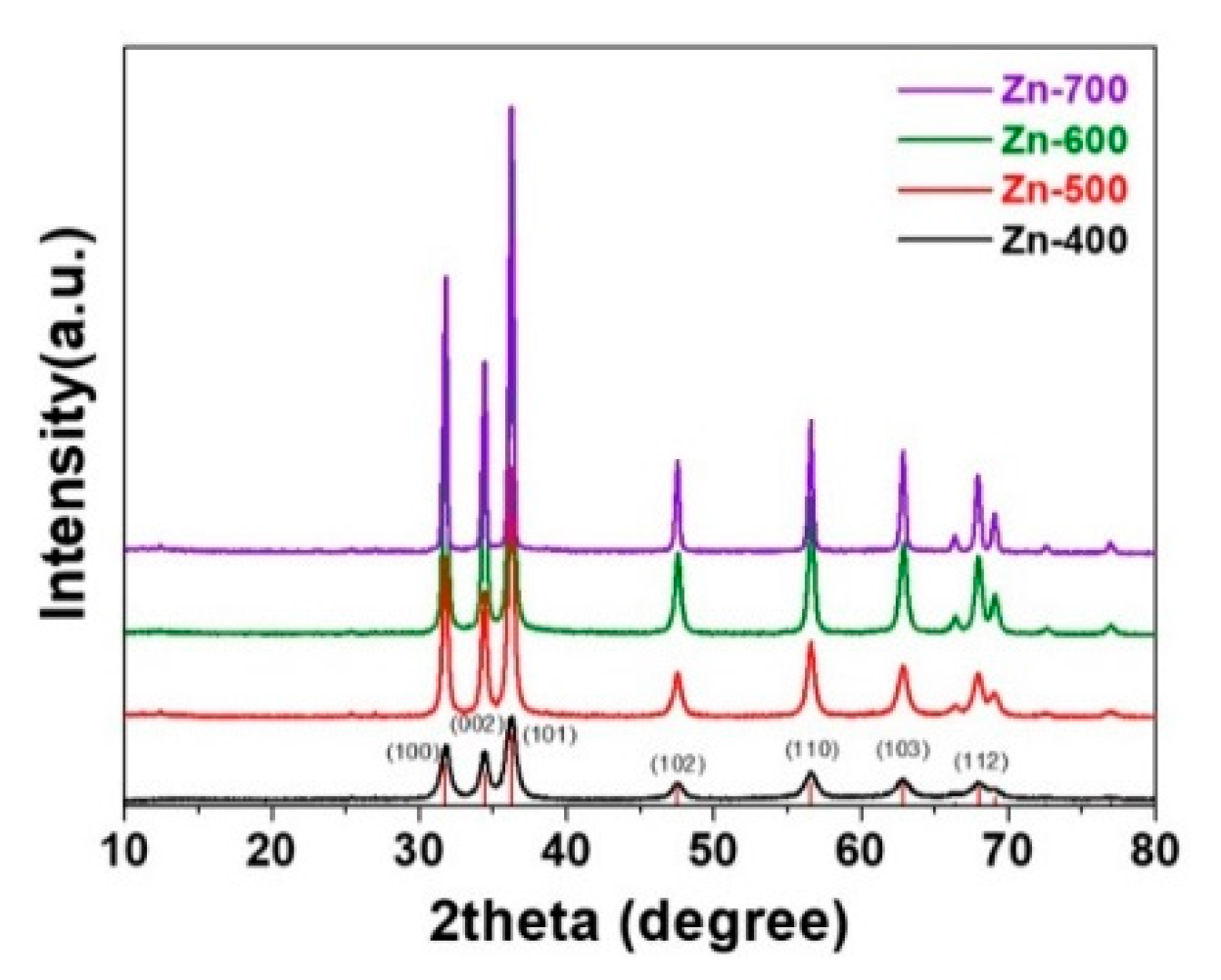
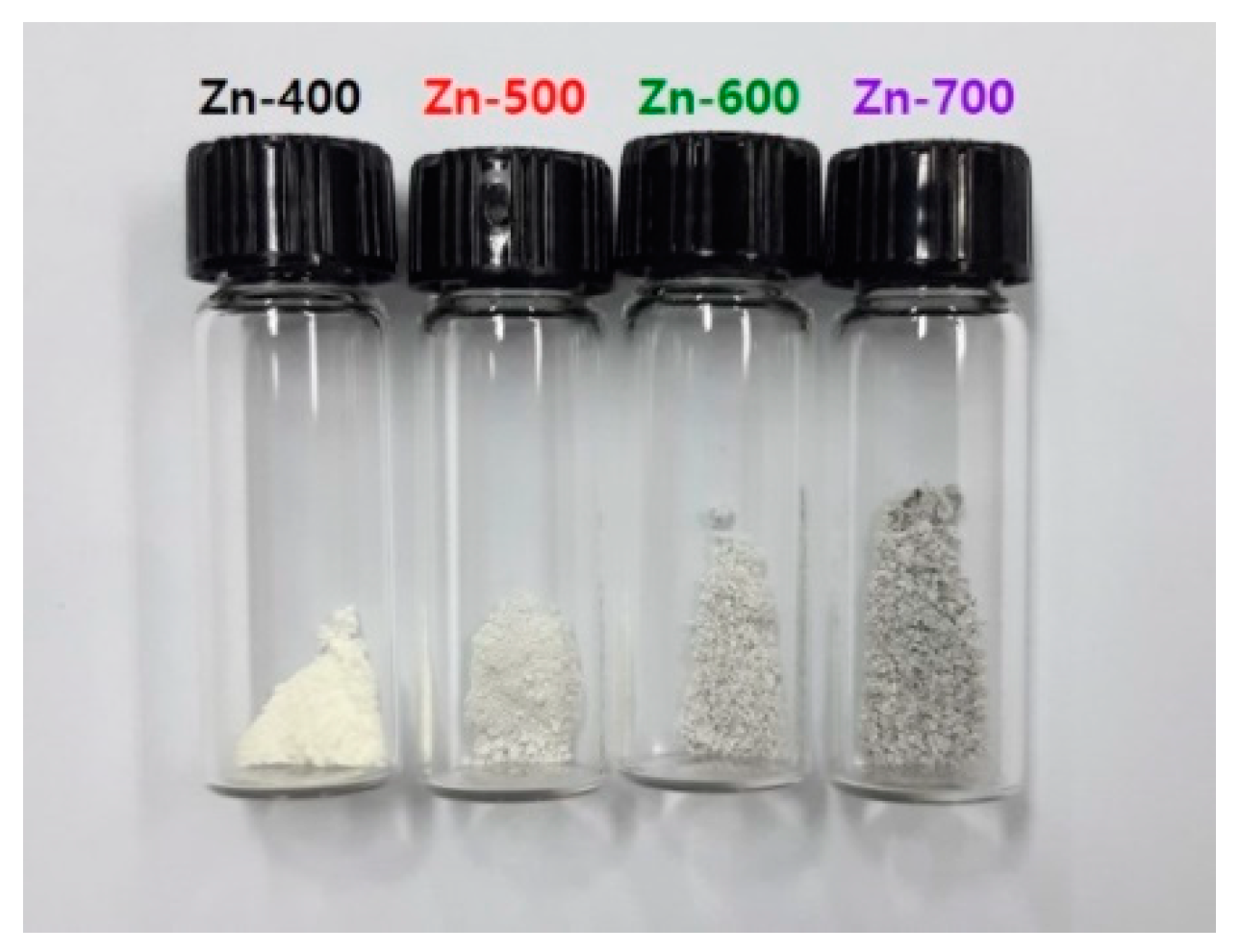

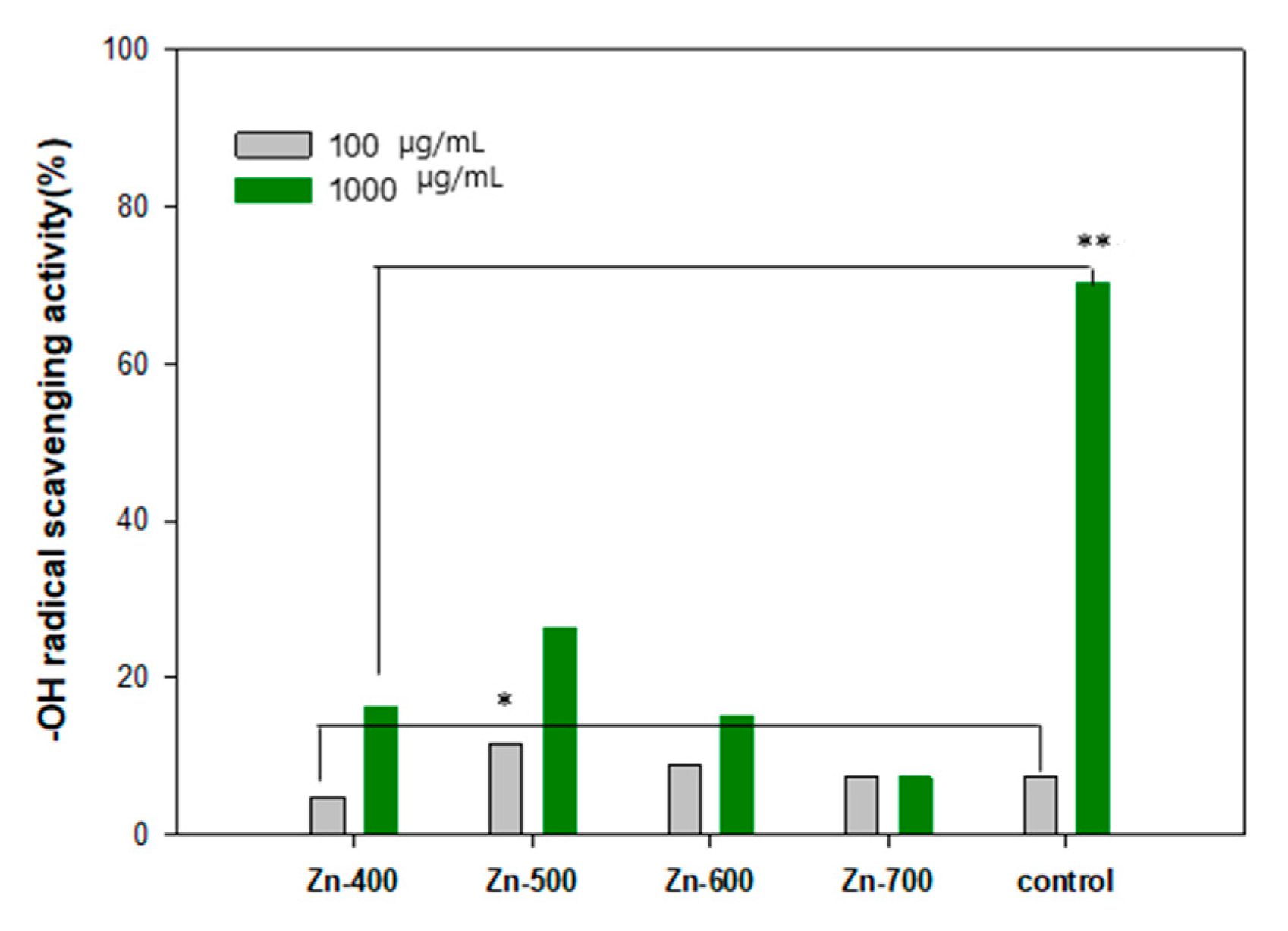

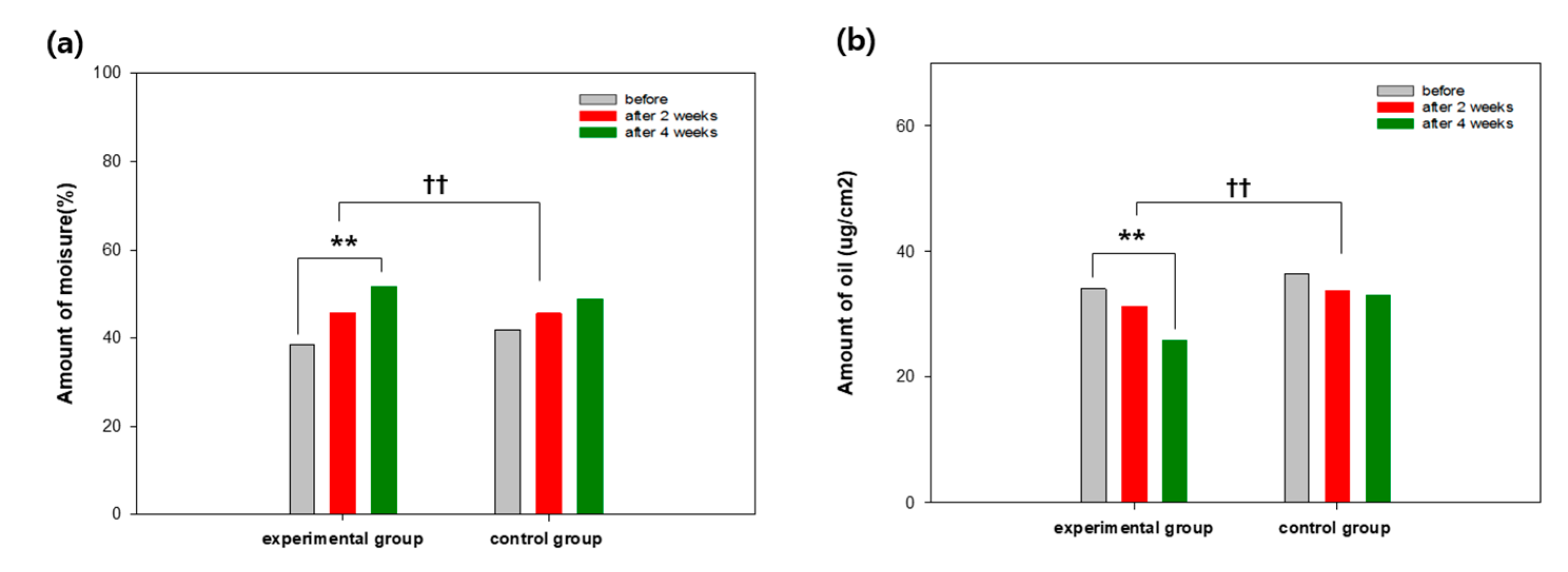
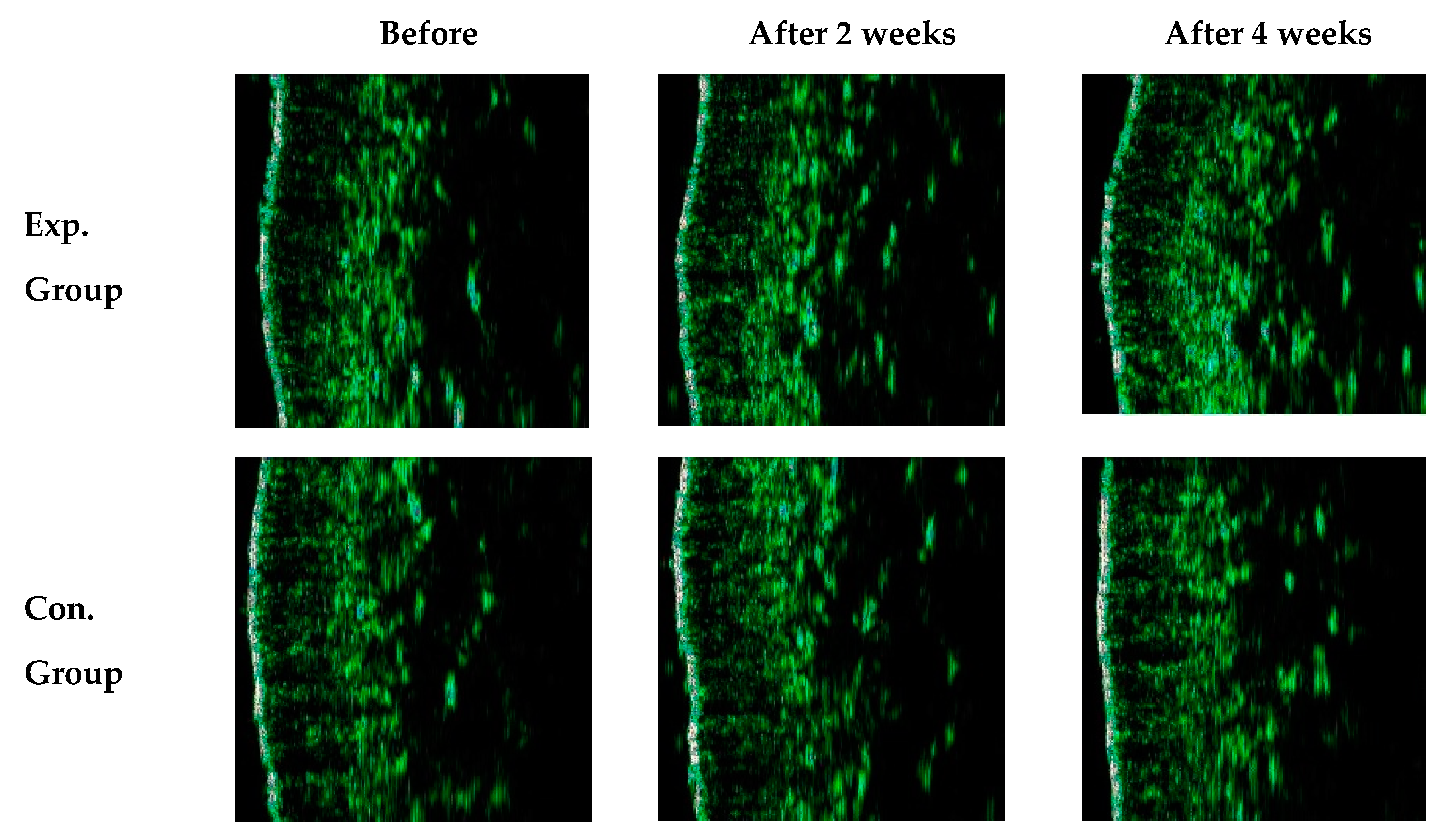
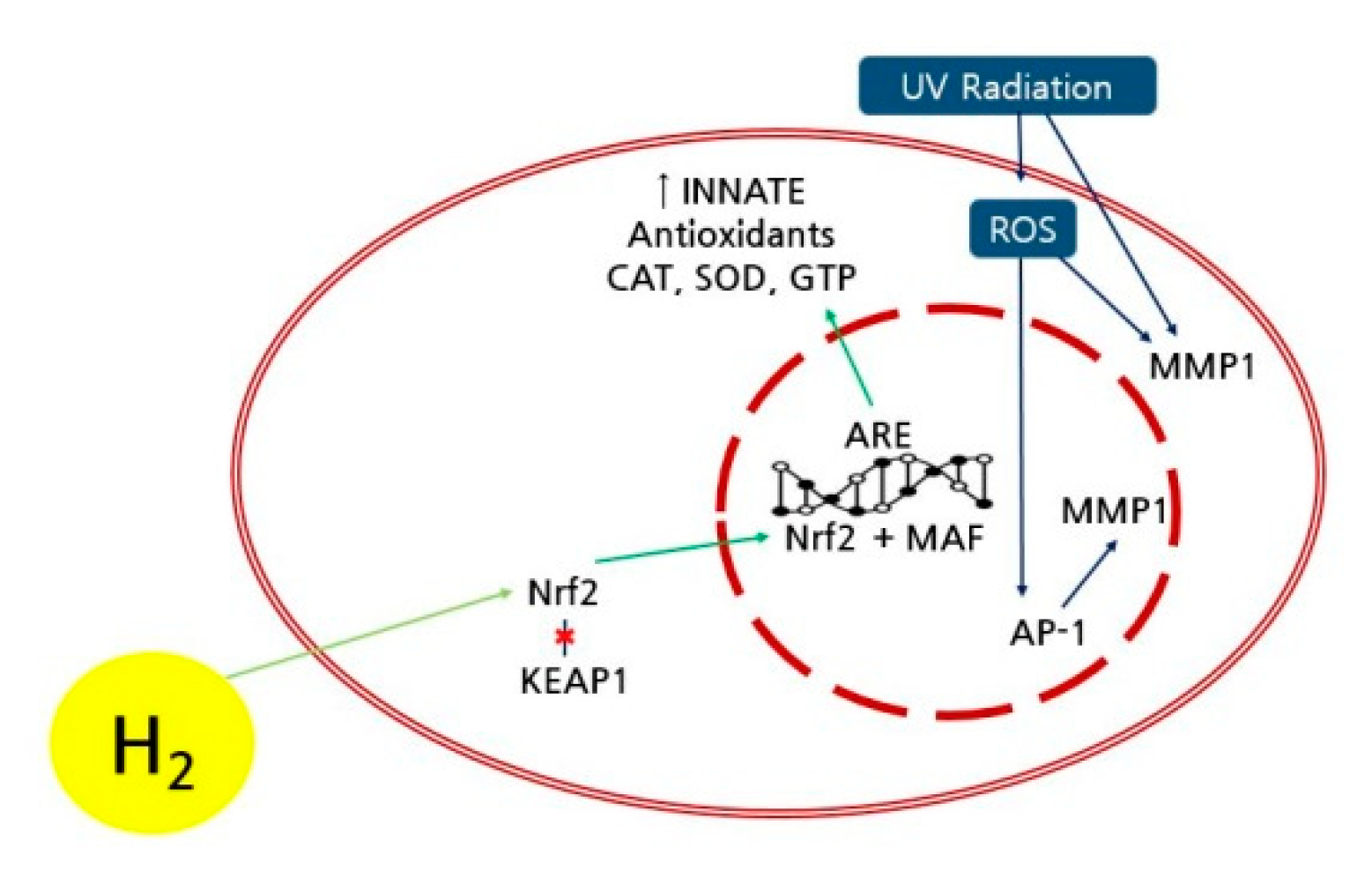
| Sample | Optical Density Value@700 nm |
|---|---|
| Zn-400 | 0.297 ± 0.001 |
| Zn-500 | 0.294 ± 0.002 |
| Zn-600 | 0.308 ± 0.001 |
| Zn-700 | 0.307 ± 0.001 |
| A commercial sample | 0.292 ± 0.001 |
Publisher’s Note: MDPI stays neutral with regard to jurisdictional claims in published maps and institutional affiliations. |
© 2020 by the authors. Licensee MDPI, Basel, Switzerland. This article is an open access article distributed under the terms and conditions of the Creative Commons Attribution (CC BY) license (http://creativecommons.org/licenses/by/4.0/).
Share and Cite
Kwon, H.-J.; Han, S.-B.; Park, K.-W. Antioxidant Activity of Hydrogen Water Mask Pack Composed of Gel-Type Emulsion and Hydrogen Generation Powder. Int. J. Mol. Sci. 2020, 21, 9731. https://doi.org/10.3390/ijms21249731
Kwon H-J, Han S-B, Park K-W. Antioxidant Activity of Hydrogen Water Mask Pack Composed of Gel-Type Emulsion and Hydrogen Generation Powder. International Journal of Molecular Sciences. 2020; 21(24):9731. https://doi.org/10.3390/ijms21249731
Chicago/Turabian StyleKwon, Hye-Jin, Sang-Beom Han, and Kyung-Won Park. 2020. "Antioxidant Activity of Hydrogen Water Mask Pack Composed of Gel-Type Emulsion and Hydrogen Generation Powder" International Journal of Molecular Sciences 21, no. 24: 9731. https://doi.org/10.3390/ijms21249731




